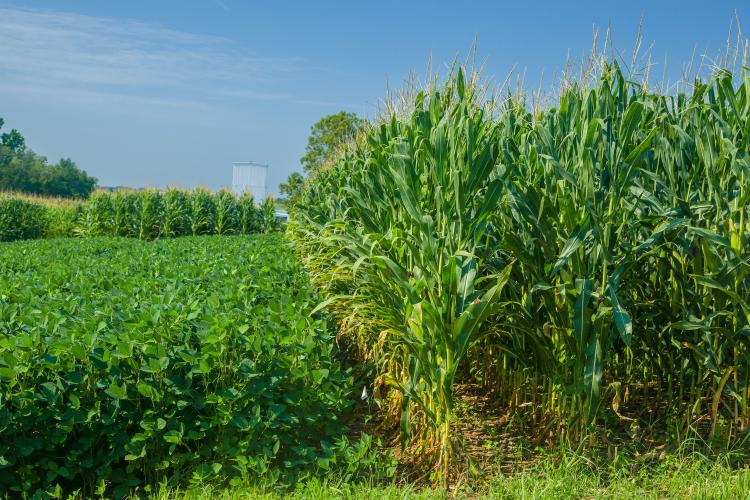Historical Corn and Soybean Yield Improvement in Kentucky
Historical Corn and Soybean Yield Improvement in Kentucky

It won’t be long before Kentucky farmers start planting the 2025 corn and soybean crops. At this time of the year, farmers are always optimistic, expecting record yields if the weather cooperates. This expectation is a result of the yield trends over the last nearly 100 years.
Corn yields in Kentucky trended upward since 1940 (Fig. 1), that’s 84 years of steadily increasing yield (ignoring fluctuations due to weather). If one takes the long view, however, increasing yield was not always a given (Fig.1).
Corn yield did not change from the time of the Civil War (1866) to roughly the beginning of World War II (1940) (Fig. 1). The yield curve during this period was flatter than a pool table, creating a yield plateau that lasted for 74 years. It’s hard to imagine a situation where a farmer’s corn yield was the same as his father’s or even, perhaps, his grandfather’s. Now that’s a significant plateau! Yield during this period averaged 24.3 bushels pr acre in Kentucky. This plateau was not limited to corn in Kentucky; corn in all the Corn Belt states, wheat in Kentucky and other crops in other countries exhibited similar plateaus.
There was no plateau for soybean (Fig. 1) because it was not grown for grain in the US until the early 1900’s and yields were not estimated by the National Agricultural Statistics Service until 1924. Soybean yield trended upward from 1924, when the yield was 11 bushels per acre, until the present. The initial yield increases were probably a result of producers learning how to grow this new crop and selecting better lines from the initial lines introduced from China.
Midwestern agriculture during the plateau period for corn was low-input, obviously sustainable (it lasted for 74 years) and would probably be considered organic by today’s standards. Cropping systems were based on rotations including corn, small grains (wheat and oat) and hay. Nitrogen came from animal manure and legumes in the rotation. Weeds were controlled by mechanical cultivation (there were no herbicides), farmers grew open-pollinated corn varieties, saved their own seed and farms were small (< 50 acres).
Animal power was replaced by the internal combustion engine and mechanization replaced hand labor near the end of the plateau. These changes greatly reduced the need for feed production and probably improved the efficiency and timeliness of management operations.
Extension programs in the early 1900’s trained farmers to identify the perfect corn ear to save for seed for the next crop. University research focused on soil fertility and other aspects of crop management. Interestingly, none of these activities had any effect on yield and the plateau persisted.
Some cataclysmic change in crop production systems in the 1930’s ended the plateau and initiated the period of steady yield growth that continued to the present day. The big question is - what change(s) drove the steady increase in yield?
Open-pollinated varieties were replaced by hybrids (hybrids were planted on nearly 90% of the acres in Kentucky by 1950) which forced farmers to buy their corn seed from commercial companies. The use of inorganic fertilizers increased rapidly after 1945, fueled, in part, by the availability of nitrates from plants that produced explosives during World War II. The development of herbicides and pesticides improved weed, insect and disease control. These inputs were supported by changes in management practices (e.g., higher corn populations, narrow rows – made possible by herbicides and mechanization – and better disease and insect control). Some argue that changes in the environment (e.g., more solar radiation resulting from the clean air act and a cleaner atmosphere) contributed to yield growth. These changes stimulated a dramatic shift from a low- to a high-input system during this period with a big increase in off-farm inputs.
The work of plant breeders was the driving force behind the increase in corn and soybean yields. The changes in inputs and management practices were essential, but they would not be effective without improved higher-yielding hybrids and varieties. You can’t manage a 1960s hybrid to produce today’s yields and today’s hybrids won’t produce today’s yields with 1960’s management. Hybrid (variety) vs. management is the classic interaction – neither can get the job done on their own.
T. R. Malthus, a preacher and economist in England, argued in his 1798 book (An Essay on the Principle of Population), that exponential population growth would always outpace the linear growth in food supplies so that humankind would always live on the ragged edge of starvation. World population in 1798 was roughly 1 billion, now, 226 years later, the population is 8.2 billion and the world faces an obesity epidemic - Malthus was wrong. He did not anticipate the dramatic growth in crop productivity and the area cropped in the high-input era that outpaced population growth to maintain a generally well-fed world. The key to the growth in yield was the efforts of plant breeders that produced improved hybrids (varieties), management practices that allowed them to reach their potential productivity, and an agri-business system that made the necessary inputs readily available to producers.
But what will the future hold? Will yield growth continue in the more hostile environments created by climate change or will it plateau, ultimately proving Malthus correct? I would be optimistic, especially given the declining rate of population growth, if it were not for the looming presence of climate change and societies’ apparent unwillingness to do anything about it.
“They are ill discovers that think there is no land when then can see nothing but sea” Francis Bacon, essayist, philosopher and statesman, 1561-1625.
Adapted in part from: Egli, D.B. 2008. Comparison of Corn and Soybean Yields in the United States: Historical Trends and Future Prospects. Agron. J. 100: S-79 – S-88.
Citation: Egli, D., 2025. Historical Corn and Soybean Yield Improvement in Kentucky. Kentucky Field Crops News, Vol 1, Issue 3. University of Kentucky, March 14, 2025.
 Dr. Dennis Egli, UK Professor Emeritus
Dr. Dennis Egli, UK Professor Emeritus
(859) 218-0753
degli@uly.edu
